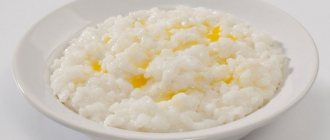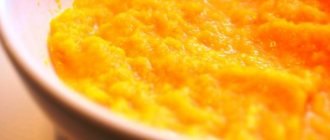Home / Newborn / How to cook porridge for an infant
43458
6
- Cereals: what are they?
- First porridge: when to start
- Features of feeding
- First porridge: buy ready-made or cook it yourself?
- Oat milk porridge recipe
- Useful video on how to cook porridge using the mixture
Porridge is a special type of dish made from various cereals and legumes. At first glance, it seems that preparing it is not so difficult, because it is based on cereals and the liquid in which it is boiled. But this impression is wrong, and a long time ago there were even specialists in this field - cooks.
However, every mother should be able to and know how to cook porridge for a child, even if she has such a profession, because porridge is the first dish in a baby’s life after breast milk.
When to introduce complementary foods?
The timing of the start of complementary feeding for different children is set individually and depends on several factors.
- Nature of nutrition. Children who are breastfed, as a rule, are introduced to complementary feeding later than formula-fed children, at about 6 months. At the same time, if the child does not show any interest in adult food and still has enough breast milk, introduction to cereals can be postponed for another 1-2 months. For bottle-fed babies, complementary foods can be introduced faster because their digestive system is more prepared, but not earlier than 4 months - this is the critical starting point.
- Baby's activity and weight gain norms. By the time complementary feeding is introduced, the baby should double its weight. If this does not happen, the pediatrician recommends introducing complementary foods earlier and starting with cereals. A similar decision can be made for active children who usually gain weight poorly.
- Teething and concomitant diseases also influence the decision to introduce complementary foods.
That is why you first need to find out whether the child is ready to get acquainted with new food for him, and only then decide which porridge to start complementary feeding with. There is no need to rush things, and then the introduction of complementary foods will not cause any trouble or disappointment to either mother or baby.
How should you start complementary feeding?
Regardless of which product is chosen to start complementary feeding, there are some rules for its introduction, which all pediatricians agree with without exception.
- Firstly, complementary foods should be introduced gradually, starting with half a teaspoon, increasing the volume daily to the age norm for the child. The next product should be introduced no earlier than the third week of starting complementary feeding.
- Secondly, with each new product, parents should monitor the baby’s reaction, and if any alarming signs appear, such as constipation or allergies, the introduction of this dish should be discontinued.
- Thirdly, the consistency of all baby foods for complementary feeding should resemble breast milk. When the baby gets acquainted with new food, the consistency can be made thicker.
- Fourthly, complementary feeding should start with dairy-free cereals such as rice or buckwheat. And only after the baby has mastered them well, you can begin to get acquainted with milk porridges.
When should you start training your baby?
To start complementary feeding, at least six months must pass from the birth of the child. Before starting, be sure to visit a doctor to check the baby for allergic reactions and physical indicators: weight, height. The pediatrician will determine exactly the time when you can start feeding porridge.
It is important for parents to do everything correctly, so you need to be as careful as possible so as not to cause stomach problems.
Basic recommendations for first feeding:
- For the first time, choose the most pure product that does not contain chemical additives: glucose, sucrose, sugar.
- Buy the pharmacy version first, but before that, check with the manufacturer. Porridge from the pharmacy has a balanced composition that does not cause allergies in the baby.
- Chalked buckwheat or corn grits are well digested, and then you need to expand the menu so that the body gets the necessary nutrients.
Porridge: homemade or store-bought?
When the product from which complementary feeding is introduced has already been determined, parents face a new problem: is it better to buy ready-made porridge in a pack or prepare it yourself? Each parent must decide this question for themselves, taking into account the advantages of each option. If you listen to the opinion of the pediatrician, then the question here is clear - doctors advocate the use of ready-made instant cereals.
Advantages of store-bought cereals:
- the consistency of store-bought porridges is homogeneous, tender and uniform, which is ideal for the children's digestive system;
- their composition is balanced, they are hypoallergenic and designed for a specific age;
- The cooking speed of packaged porridges is much higher; they are convenient to prepare even in small portions.
When porridge can replace one feeding of a child, he can be switched to homemade cereals. However, doing this at an early age is not advisable.
Which porridge should I introduce complementary foods with?
Even if the family, and the child in particular, has no predisposition to allergic reactions, complementary feeding should be introduced with gluten-free cereals. Thus, grains that contain gluten should be excluded (rye, wheat, oats, barley). Then the question arises: what porridge to start complementary feeding with?
There are three types of gluten-free cereals that are safest for children:
- buckwheat;
- rice;
- corn porridge.
Buckwheat is considered an ideal grain for first complementary feeding. It has valuable proteins, vitamins and amino acids. In addition, cereals have a low level of hypoallergenicity, saturate the body with iron, increasing the level of hemoglobin in the blood, improve intestinal motility, and relieve constipation.
Rice should be introduced into the baby’s diet after buckwheat. This is the only cereal that contains all 8 amino acids. It is hypoallergenic and helps cope with diarrhea. The only drawback is rice porridge. Complementary feeding with it should absolutely not be started for children suffering from constipation.
Corn grits are introduced into the diet no earlier than 7-8 months, after buckwheat and rice. It has a rich vitamin and mineral composition and helps get rid of constipation. Gradually, you can add healthy fruits and berries to the porridge.
Cereals: what are they?
You can find a wide variety of cereals on store shelves, but not all of them are suitable for feeding a small child. When choosing the first cereal for complementary feeding, you need to give preference to those that have the following properties:
- Single-component, that is, there is only one grain in the composition. This is due to the fact that it will be easier to calculate an allergy to a specific component, unlike multigrain products.
- Gluten-free, because in most cases gluten is poorly digested and often causes allergies and stomach diseases. These include oatmeal, semolina, millet and barley groats.
- Dairy-free, since cow protein can cause allergies, and is a very difficult food for babies.
Knowing how to properly cook porridge for a child, choose the following three types of cereals to start complementary feeding:
- Buckwheat is the lowest allergen, so almost all children tolerate it well. It is easily digestible, but at the same time contains complex carbohydrates, which provide the child’s body with energy for a long time. In addition, buckwheat is one of the richest sources of iron, which is very important for the rapid growth of a child in the first year of life. Read more about how to prepare delicious buckwheat porridge for a child?
- Rice is very nutritious and rich in B vitamins. For children who have a tendency to loose stools, rice is the undoubted leader, because it “strengthens”.
- Corn is children's favorite porridge. It is nutritious and contains many useful microelements.
After the child grows up a little, you can introduce porridge from the following cereals into the diet::
- Oatmeal is a porridge for babies, rich in antioxidants and is the healthiest grain from the point of view of nutritionists. In addition, it has a slight laxative effect.
- Millet is good for the cardiovascular system, but it is digested very slowly.
- Semolina is very high in calories, so it helps you gain weight. But in the first year of life it is better to give it up, and subsequently use it as a treat rather than a daily breakfast. Learn more about how to cook semolina porridge for babies?
How to prepare porridge for the first feeding?
If parents nevertheless chose home-made porridge to introduce complementary foods, then they should prepare in advance for the cooking process and make flour from cereals.
How to prepare porridge for the first feeding?
- The cereal is washed several times until the water is completely transparent.
- Next, the cereal is dried naturally on a napkin or in the oven and ground into flour.
- Heat water (100 ml) in a small saucepan on the stove.
- A teaspoon of cereal flour is added to the water and boiled for 15 minutes with thorough mixing.
- Transfer the remaining flour into a glass jar with an airtight lid and store in a dark place.
Before feeding your baby, you should learn in advance how to introduce porridge into complementary foods. For this purpose, entire schemes have been developed that must be adhered to.
Complementary feeding scheme
First of all, these schemes were developed in order to avoid a negative reaction from the use of a new product on the child’s body. Digestive problems, constipation or diarrhea, flatulence and allergies are just a small part of the troubles that can happen to a child due to improper introduction of complementary foods.
So, how to introduce porridge into complementary foods? Rules and introduction scheme:
- A new product should be introduced into the diet only when the child is completely healthy and is not teething.
- How to prepare the first complementary food? Buckwheat porridge (this is the cereal you should start with) is diluted to the consistency of breast milk.
- The first portion of porridge is 0.5 teaspoon, the next day – 1 teaspoon, then – 3 spoons. Gradually, over 7 days, the volume should be increased to 150 ml.
- After 3-4 weeks, if the child does not have any negative reactions to this product, you should begin to introduce a new porridge into the diet.
The meaning and nutritional value of porridges
A special place among various types of complementary foods is occupied by grain-based products - porridge. It is well known that by 4-6 months of life a child’s need for both additional energy (calorie intake) and microelements and vitamins increases. The nutritional value of porridges is determined, first of all, by the nutritional value of flour or cereals, which are their basis. All types of grain products are important sources of carbohydrates, the content of which varies in different types of flour and cereals (the largest amount of carbohydrates is contained in rice - 60-70%). Porridges contain a small amount of protein (7-13%) and fat (0.7-7%). With a relatively similar composition of basic nutrients, different types of cereals and flour differ significantly in the level of vitamins and mineral salts in them. In this regard, buckwheat and oatmeal, which contain the largest amounts of vitamins B1, B2, magnesium, and iron, have an undoubted advantage. Cereals also differ in the content of dietary fiber, which has a beneficial effect on the intestinal microflora by increasing the growth of beneficial bacteria: minimum - in semolina and rice cereals, maximum - in buckwheat, oatmeal and millet.
How to choose porridge in a store
Most parents are of the opinion that it is better to buy porridge for complementary feeding in the store. It is optimized for a child’s body, and it saves a lot of time on cooking. All that remains is to figure out how to choose porridge for complementary feeding in the store.
- First of all, you should choose dairy-free, one-ingredient cereals that do not contain gluten. This protein of plant origin is not absorbed by the child’s body, which can lead to serious disruptions in its functioning.
- Pay attention to the composition; it should not contain flavorings, sugar, fructose and other sweeteners and additives.
- The porridge must be appropriate for the age of the child for whom it is purchased.
- Check expiration dates, compliance with storage conditions, and integrity of packaging.
The first porridge for a child should not contain any additional components in the form of an apple or berries. They need to be introduced into the baby’s diet a little later. If you have already decided which porridge to start complementary feeding with, it is enough to buy one package of this product. Perhaps the child will not like the porridge from this manufacturer, and it will urgently need to be replaced with a new one.
What do you need to do to prepare rice flour?
Before preparing porridge for a child, you need to prepare flour from rice, oatmeal or buckwheat, because it is best to make your own flour from whole grains. This flour must be prepared in advance before preparing the porridge. Grains are poorly digestible by a child’s stomach if left in a “raw” state.
To prepare rice flour, you must use a coffee grinder or a special cereal mill. These kitchen appliances should be used only for cereals, so that small particles of other products do not get into the baby’s porridge. If you are using an old coffee grinder, wash it thoroughly and dry it, then grind a little grain and throw it away. Then you can use it for its intended purpose. However, the most convenient thing is a special mill for cereals, for example, I have an old Soviet mill in the form of a meat grinder, in my family it wanders from child to child, my aunt, my mother, cousins, etc. used it, and as a result I got it and to me, and after that I will give it to my brother’s wife, etc. However, you should not think that such a mill is a useless thing; first you use it to prepare porridge for your baby, and then there are many adult recipes made from rice or oatmeal. If you no longer need it at all, you can give it to a friend with a small child, or use it for pepper. However, it is worth saying that after pepper it should not be used to prepare cereal flour; the persistent smell and taste of pepper will be present in baby porridge.
Rating of baby cereals
Parents who are faced with the need to introduce complementary foods to their child for the first time are often lost in the store when they see the assortment. The following rating of complementary feeding cereals will help you make the right choice in favor of one package or another. For several years in a row, the top three have included products from the Nestle, Gerber and Heinz brands. Among Russian brands, the most popular among buyers are Malyutka and Spelenok porridges.
Despite the rating, it is important to familiarize yourself with the ingredients on the packaging right in the store. Because even famous manufacturers sometimes add components to porridge that should not even be present. This is the only way to protect your child from low-quality complementary foods.











